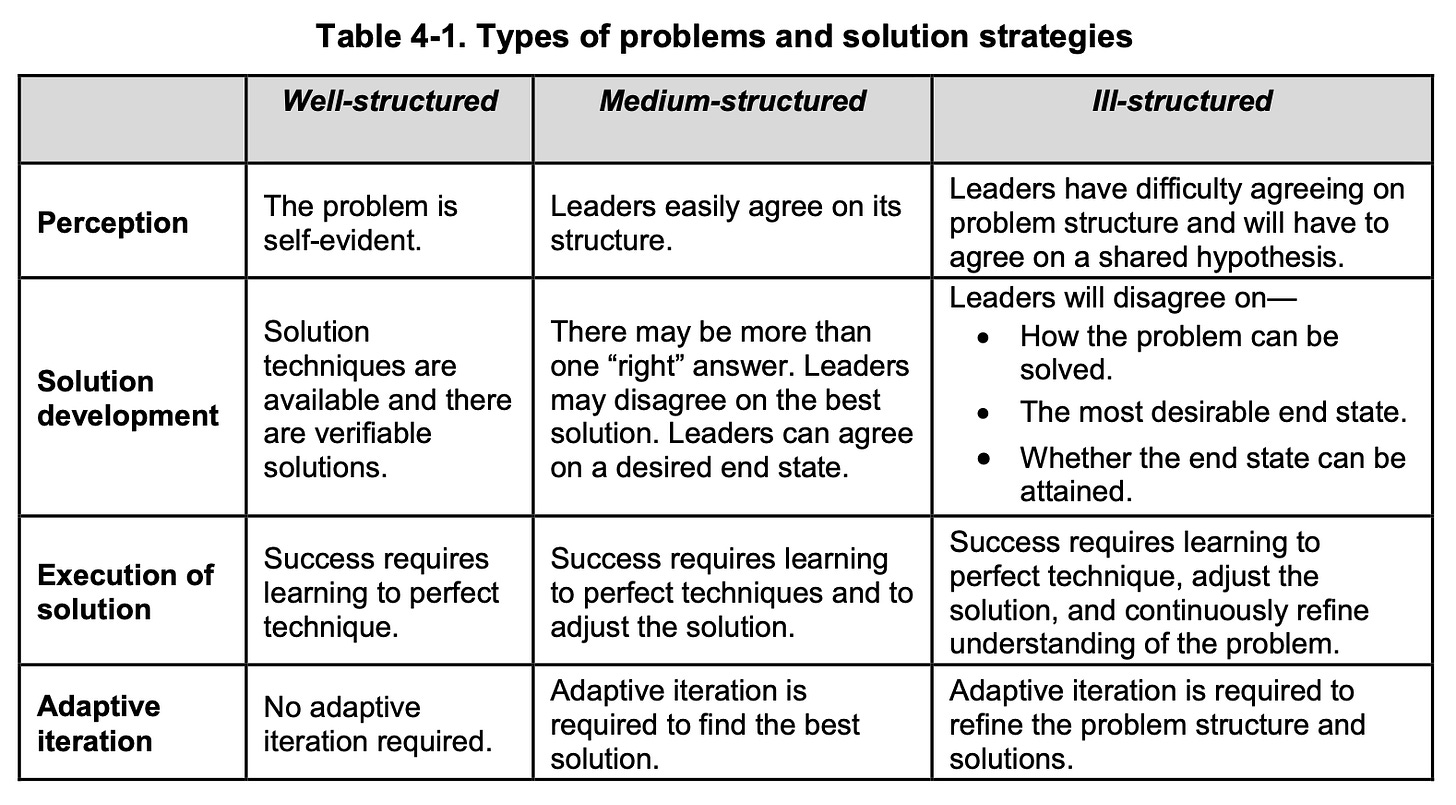Your Problem Has a Type
Study.

What problem are you trying to solve?
Borrow One Idea: Determine a Problem’s Structure
Making life plans in 2025 is not easy.
Current trends, global events, the pace of technological change, rapidly shifting cultural norms, increasing dramatic socioeconomic turbulence.
In the course of human history has it ever been this difficult to make long-range life plans with confidence?
Yes.
It might have been similarly challenging in the 1940’s, during a world war. Or during the 1970’s, when western countries were flailing. Or during the 1890’s, when communication and transportation advancements were progressing at an exponential rate and immigration to America was restructuring most cities.
Or, maybe it wasn’t. Not because life was not previously messy and complex, but because the individual and societal expectation to make ‘life plans’ did not exist. Maybe people just lived their lives, without a plan?
Perhaps that is incorrect as well, and all then was as it is today: life planning is the provenance of the more financially secure. Perhaps there is just more planning now because increasing human wealth and satisfaction of base needs has naturally resulted in more time to make plans?
I’d hypothesize it is the result of humans having more time, but also having more of three additional ingredients:
Increased understanding of available options;
Improved information detailing how to access or achieve options;
Expanded individual agency to execute plans via structural, regulatory, and educational enhancements.
Life planning in 2025 feels complex for many reasons, but few of those reasons are related to scarcity. Too many options, too much information, and the possible lack of restraints on agency add significant complexity, blurring the lines between distinct problems and expanding the scope of the problems we might need to solve.
The current problems complicating our ability to effectively life plan in 2025 are real, but the actual level of complexity is also a result of how we perceive the problems.
Army leaders are problem solvers and the complexity of problems they address range from well- structured problems to those extremely complex and ill-structured. The degree of interactive complexity of a given situation is the primary factor that determines the problem’s structure. Another factor determining problem structure is an individual perception of a problem. Perception of whether a problem is well, medium, or ill-structured depends on the perceived familiarity and understanding of the problem.
Right now, as humans trying to life plan, the perception is largely that we are dealing with ill-structured problems. Some problems are truly ill-structured at present, for example, ‘what role will AI play in my child’s career and how do I prepare them for it?’ is an expansive quandary.
More questions, however, only seem ill-structured because humans have a tendency to bundle problems, regardless of whether they are truly connected.
3-17. Ill-structured problems are the most challenging to understand and solve. With ill-structured problems—
Leaders often disagree on what the true problem is or cannot agree on a shared hypothesis.
Leaders often disagree on how to solve the problem.
The problems are complex and involve many variables, making them difficult to accurately analyze.
Leaders may disagree on the desired end state.
Leaders may disagree on whether an end state is achievable.
They may require multiple solutions applied concurrently or sequentially. Problem solvers must sometimes reduce complex ill-structured problems into smaller problems.
FM 5-0, 3-17, PDF page 61
Breaking an ill-structured problem into smaller problems generally results in a larger set of well- and medium-structured problems (the US Army notes that most problems leaders need to solve are of the medium variety).
Problem structure is a result of actual complexity + perception. Perception is a result of familiarity. Right now, humans are faced with problems that are actually complex and that are appearing in contexts that lack familiarity. But this does not mean our problems are entirely ill-structured. It means we need to structure our problems better.
In the coming weeks, Borrowing with Pride will focus leveraging military decision-making and planning processes to build and improve life planning. We’ll begin with basic techniques (Army Problem Solving), then move to methods (Army Design Methodology), and then spend time on process (Military Decision-Making Process) as tools to assist us in developing our personal, professional, strategic and tactical life plans.
The first step is determining what the problem is and how it is structured.
This week, borrow with pride and define the life planning problem(s) you are trying to actually solve. How is it structured? Are there differences in perception as to the problem and/or the complexity? Where do you need alignment or agreement to begin solution development? Does it need to be be broken down into smaller problems?
Get Familiar With: Problem Solving
3-1. The ability to recognize and effectively solve problems is an essential skill for leaders. A problem is an issue or obstacle that makes it difficult to achieve a desired goal, objective, or end state. Army problem solving is a form of decision making. It is a systematic approach to defining a problem, developing possible solutions to solve the problem, arriving at the best solution, and implementing it. The object of problem solving is not just to solve near-term problems, but to also do so in a way that forms the basis for long-term success.
3-2. Not all problems require lengthy analysis to solve. For simple problems, leaders often make decisions quickly—sometimes on the spot. However, for complicated problems involving a variety of factors, a systematic problem-solving approach is essential. How much analysis is required to effectively solve a problem depends on the problem’s complexity, the leader’s experience, and amount of time available.
FM 5-0, 3-1 and 3-2, PDF page 45
What problem are you trying to solve? Do you use the same technique to solve all problems? Do you have a technique? Is problem solving a reactive or proactive process? Do you problem solve for the near-term or in a way that supports long term success?
The Guided Discovery for this week will consider the US Army’s approach to problem solving, how to define problems, and the logical process to effectively navigate and make choices in our professional and personal lives.
Learn More: Suggested Reading
FM 5-0, Planning and Orders Production
Chapter 3, pages 45-54 based on printed document (PDF pages 59-66)
US Army perspective on structuring and logically addressing problems
These materials will be the focus of Thursday’s Guided Discovery
Catch Up: Last Week’s Content
Study: Posture
Guided Discovery: Drill & Ceremony
Always be asking:
1. What is the connection with my leadership development?
2. How does this change my thinking on management?
3. How does this influence planning for life?
4. What can I borrow with pride to use this week?

